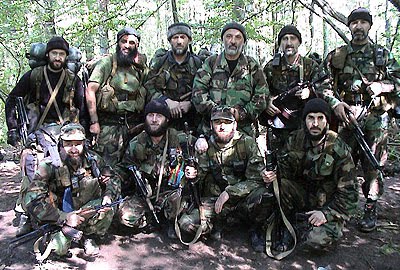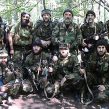
Rebels in Chechnya Regroup in Rare Meeting of Field Commanders
Publication: Eurasia Daily Monitor Volume: 11 Issue: 146
By:

A high level of secrecy was the defining feature of the Chechen militants under the command of Doku Umarov. Even news of the split within the Chechen insurgency’s ranks was transmitted mainly by the neighboring jamaats, rather than by the Chechens. This situation has radically changed under the Chechen militants’ new head, Emir Hamzat (Aslan Batyukaev), who became leader after Umarov’s death in 2013 (Kavkaz Center, July 20).
That the unusually high level activity of the Chechen jamaat in the area of publicity is apparently a new trend that can be discerned in the multiple videos leaked to the Internet by the Chechen militants. In April, Emir Hamzat pledged allegiance to Abu Muhammad, the new emir of the Caucasus Emirate (YouTube, April 9). Only a month-and-a-half later, he repeated his pledge to Abu Muhammad, but this time with his subordinates present (Kavkaz Center, July 24).
It was unclear why this had to be repeated, but it is likely that, behind the scenes, some of the Chechen commanders did not accept the authority of the new Caucasus Emirate emir, so Emir Hamzat was forced to sit with the few remaining well-known Chechen commanders and publicly repeat his pledge of allegiance to Abu Muhammad. The second oath of loyalty was also interesting because it was the first time in the last three years that practically all the Chechen rebel commanders gathered together in one place, which is extremely risky for security reasons. The previous meeting on such a scale took place back in July 2011, when the current emir of the Caucasus Emirate, Abu Muhammad, was the Caucasus Emirate’s qadi (judge) and tried to reconcile the Chechen commanders with Doku Umarov (Kavkaz Center, July 23, 2011).
This time, the commanders, who met in a district of Chechnya, brought up new names of regional commanders within the structure of the Chechen command of the jamaat. The video of the second oath of allegiance, which was recorded on May 15 inside Chechnya, featured most of the commanders of the Chechen jamaat—Emir Islam of Urus-Martan, Emir Imam of Kurchaloi, Emir Muhmad of Sunzha, Emir Yakub (Makhran) of Tsentoroi, Emir Abdurakhman of Gudermes, Emir Hamzat of Itum-Kale, and Emir Mukhtar of Achkhoi-Martan. However, Emir Usam of Vedeno district and Emir Aslanbek were absent. This powerful display of the emirs of all the sectors of Chechnya was meant to demonstrate that the underground movement had been restored across the entire republic.
All of this could have been dismissed as a not-quite-serious show had there not been a follow-up video, posted to the Internet in early August, showing that it was too early to write off the Chechen jamaat as a thing of the past (YouTube, August 2). The voice in the video asserts that not all of the militants had managed to attend the May meeting with Emir Hamzat. The video shows about 45 people, and that is only the number of people shown on camera and does not include those who were guarding the meeting place. Bearing in mind that Emir Usam from the Vedeno sector and Emir Aslanbek from Nozhai-Yurt sector were not present, the number of rebels in Chechnya still appears to be quite formidable. On the video, Emir Imam of Kurchaloi calls for a fight against those pursuing anti-Muslim policies. He also says all of those guilty of insulting and belittling the relatives of militants will be held responsible, as the rebels are not going to forgive anyone anything. There were also videos of the Chechen jamaat posted in July and this past spring (YouTube, April 30, and others).
The appearance of one of the most famous Chechen rebel commanders, Emir Tarkhan (Tarkhan Gaziev), in the news feeds of the insurgency’s media outlets is another interesting development. Emir Tarkhan was one of the senior Chechen rebel commanders who refused to subordinate to Doku Umarov when he was emir of the Caucasus Emirate in 2010–2011. For a long time it was thought that Emir Tarkhan led a secluded life and did not communicate with other Chechen rebel commanders. However, starting in 2013, rumors spread that he was outside Chechnya, which he confirmed in a recent interview with the Chechen service of Radio Liberty (radiomarsho.com, August 6).
In that interview, Emir Tarkhan said he was outside of Chechnya and, addressing one of his subordinates in Chechnya, calling him Sheikh, he gave reassurances that he would do everything possible to return to Chechnya’s mountains. It should be noted that he is the only Chechen rebel commander who has expressed a desire to return to Chechnya: those outside Chechnya usually go to Syria as a way to justify their unwillingness to return to their homeland. And Emir Tarkhan said he wanted to return to Chechnya despite the fact that he has his own armed group in Syria (YouTube, June 5), although he himself is not in the war-torn Middle Eastern country. The fact that some Chechen fighters are prepared to consider him their emir even though he is not physically present indicates that Emir Tarkhan is a highly respected figure by some Chechens. Interestingly, the websites under the control of long-time rebel propagandist Movladi Udugov (Kavkaz Center, checheninfo.com and others, accessed August 7) did not publish any of the videos of Emir Tarkhan.
Based upon the developments mentioned above, it increasingly appears that after Doku Umarov’s death was announced this spring (Kommersant, March 19) the pressure of the Russian security services inside Chechnya has decreased, which allowed the insurgency to regroup and organize a joint meeting of militants under Emir Hamzat’s command. Claims by Russian media outlets that only “7 to 12 individuals” remain among the Chechen rebels” (RT, April 8) appear to be specious.
Thus, news will likely reemerge in the future that the Chechen Jamaat—which, unlike other jamaats in the North Caucasus, has ties to the countries outside Chechnya, above all Syria and Turkey. These ties allow the Chechen jamaat to retain the status of a strong player inside Chechnya and within the North Caucasian insurgency.




